If you’re looking for information about the ideal basement humidity level, you’ve landed on the right page. In this short article, we’ll go over what causes humidity in a basement, why you don’t want basement humidity, what the ideal basement humidity should be, how to lower humidity in the basement, and more.
What Causes Humidity In A Basement?
Basements are prone to high humidity levels because they’re below ground and surrounded by soil which often contains more moisture than it should because of poor drainage around the foundation. This moisture in the ground can infiltrate through the foundation wall via cracks that homeowners don’t even notice. This can lead to high humidity and mold growth inside the basement.
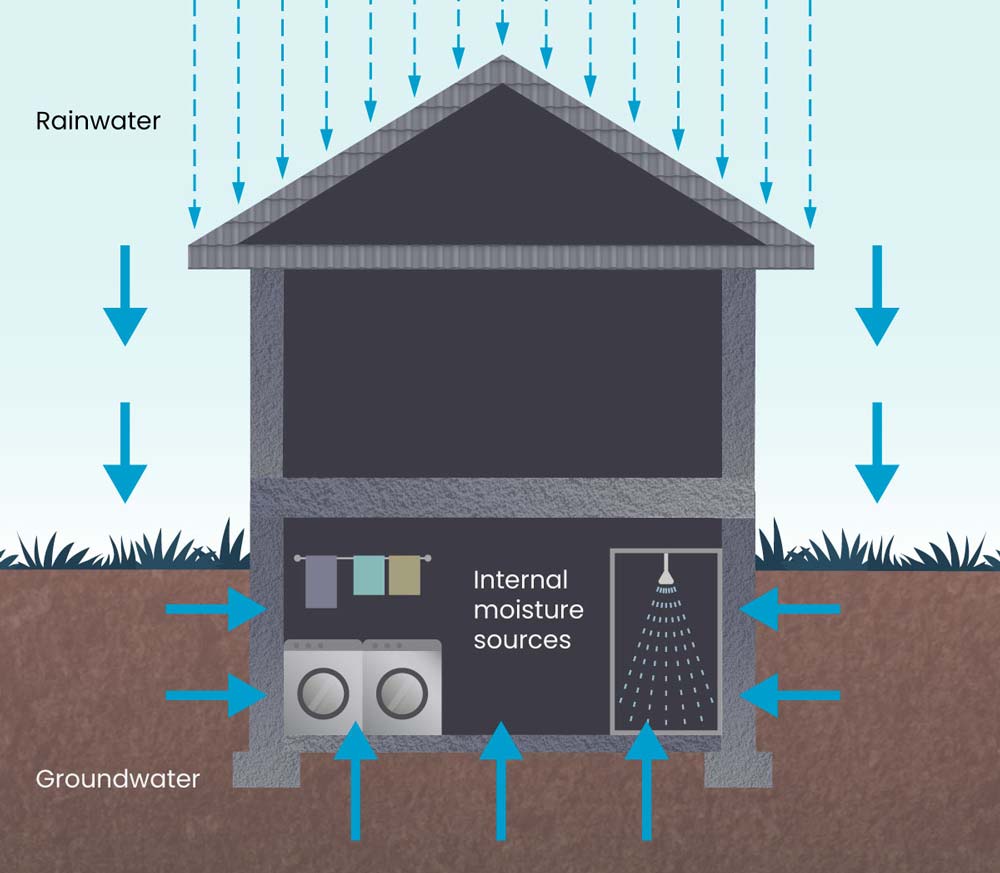
Daily activities like cooking, showering, and doing laundry can also contribute to basement humidity if they’re done in the basement. If these activities aren’t adequately ventilated, they’ll release significant amounts of moisture into the air in the basement.
Open basement windows can also increase the humidity level in the basement as the warm, humid air flows in and condenses on cooler surfaces.
Why You Don’t Want High Humidity In Your Basement
High humidity in a basement can lead to problems, including musty odors, mold growth, and damage to anything stored or located in the space. Also, since some of the air from your basement flows into your home’s living area, you don’t want basement air that’s full of mold spores.
What Should The Ideal Basement Humidity Be?
The ideal basement humidity level is between 30% to 50%. Keeping the humidity level below 50% can prevent mold growth and discourage pests such as termites and cockroaches that thrive in humid environments. A humidity level above 50% can cause mold to form.
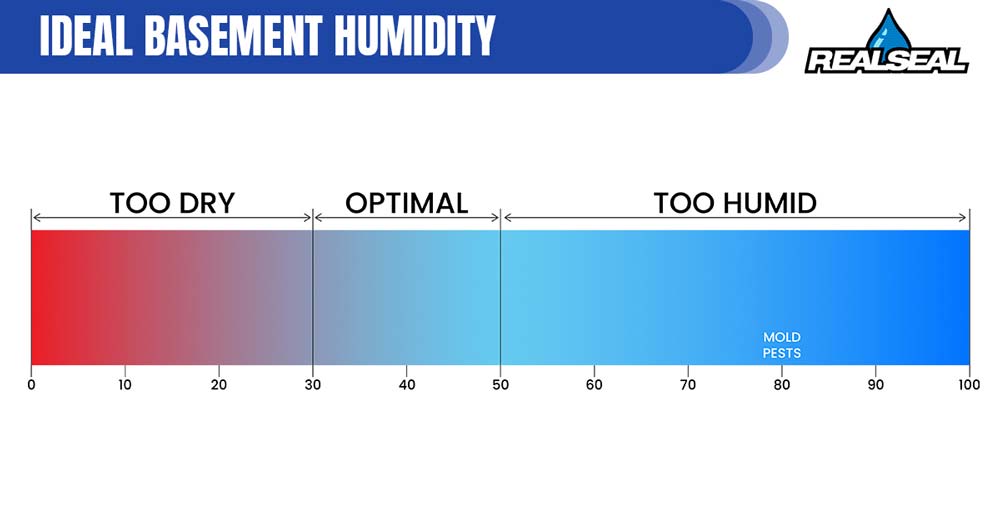
Maintaining a humidity level is not as simple as purchasing a dehumidifier and setting it up in the basement. To properly address humidity issues in a basement, it is important first to identify the source of the excess moisture. Often, the problem is excess moisture in the ground around the foundation. Therefore, the best solution is usually installing a drain tile system. We’ll talk more about how drain tile systems work in just a bit.
Signs The Humidity In Your Basement Is Too High
Signs the humidity in your basement is too high include the following:
- Condensation on windows or walls
- Visible mold growth
- A damp, musty odor
- Water stains on walls or ceilings
- A feeling of humidity
- Metal objects stored in the basement are rusting.
- Efflorescence on walls.
How To Achieve The Ideal Basement Humidity Level Of 30-50%
Installing a drain tile system is the best way to achieve the ideal basement humidity level and prevent moisture accumulation in the basement. There are two types of drain tile systems: exterior and interior.
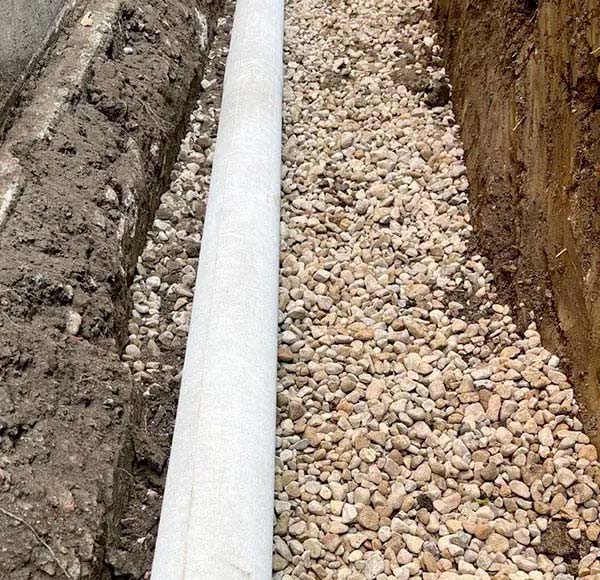
An exterior drain tile system is placed around the outside perimeter of the foundation at the footing level. Excess moisture in the ground around the foundation is collected and expelled away from the foundation via a sump pump.
An interior drain tile system is placed around the inside perimeter of the basement and functions similarly. Installing an interior drain tile system means using a jackhammer to tear up the basement floor to install the drainage system.
The general installation procedure for an exterior drain tile system is as follows:
- The soil around the perimeter of the foundation is excavated down to the footing level.
- A shallow trench is dug around the foundation’s perimeter and lined with gravel.
- A perforated drainage pipe is placed into the trench and then covered with more gravel.
- Finally, the excavated soil is replaced.
Excess moisture in the soil will now find its way into the drainage pipe and move toward the sump pit. Once the sump pit fills with water, a sump pump will turn on and eject the water away from the foundation.
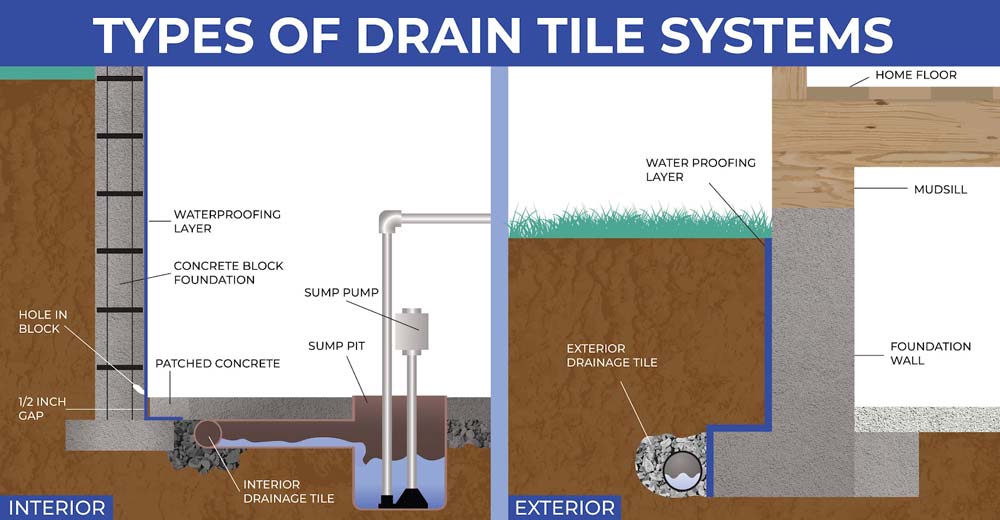
An interior drain tile system works similarly.
A drain tile system has several advantages over other alternative methods of basement waterproofing, such as exterior waterproofing or applying sealants to the walls and floors. One of the most significant benefits of installing a drain tile system is that it is a one-time installation, meaning that once it’s installed, it requires little to no maintenance apart from the sump pump.
Other Things You Can Do To Lower Basement Humidity
While a drain tile system is the best way to control moisture in the ground around the foundation, which will go a long way toward lowering basement humidity, there are some other things you can do. These include the following:
Regrade Your Yard
The primary objective of regrading is to create a sloping grade away from the foundation, allowing water to flow away from the house instead of accumulating around the foundation walls. Water will pool around the foundation when the yard slopes towards the house, resulting in moisture seepage into the basement.
Use Downspout Extensions
Downspouts are vertical pipes that transport rainwater from your roof to the ground. Without extensions, the water can pool around the foundation and seep into your basement, causing mold, mildew, and even structural damage.
Clean Your Gutters Regularly
Clogged gutters can cause water to overflow and accumulate in areas near your home’s foundation. This excess moisture in the soil around the foundation can then seep into your basement, increasing the humidity level.
Don’t Plant Water-Hungry Vegetation Next to the Foundation
When water-hungry vegetation is planted next to the foundation of a building, watering them only adds more water to the soil around the foundation. This is exactly what you’re trying to avoid.
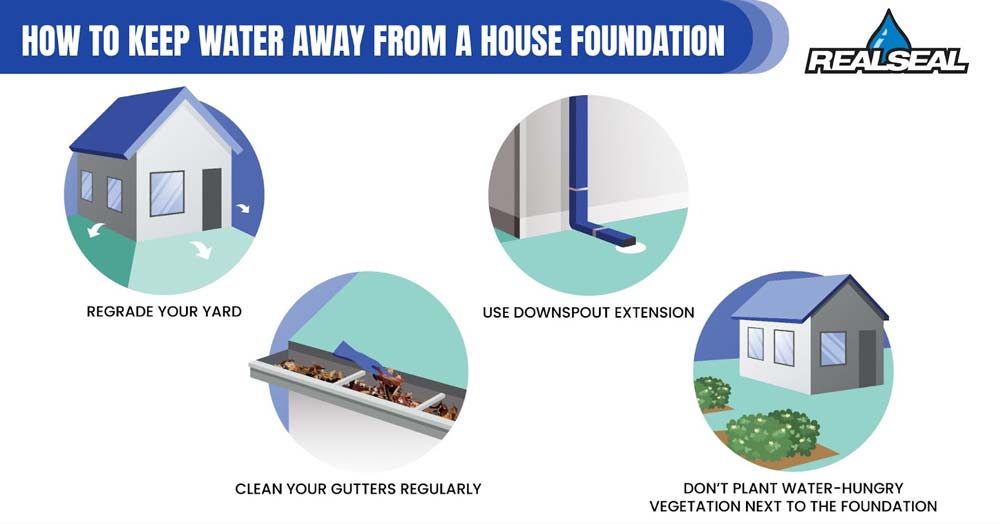
If you’re concerned about the humidity level in your home’s basement, contact The Real Seal Basement Waterproofing and Foundation Repair today to schedule an evaluation. If we find a problem, we’ll give you a repair estimate.
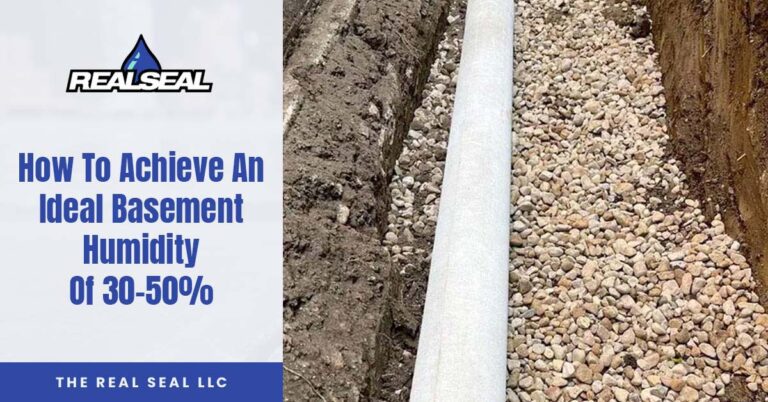
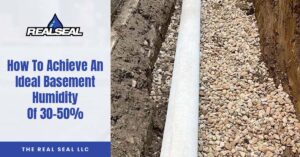





24 Responses
Tks for info article re: humidity levels.
Happy to help!
Best posting addressing humidity problems.
Thanks you Joe!
Great article!!! Thank you!! This was beneficial information!
Happy to help, thank you!
Cost is always a consideration. Please contact me regarding an external pump
Hi Brenda,
You may reach out to us at 847-756-7987 and we can set something up!
This post is incredibly helpful! I had no idea how important it was to maintain the humidity levels in my basement. The tips on using a dehumidifier and monitoring moisture sources were particularly useful. Looking forward to trying these suggestions out!
Happy to help, thank you!
Great tips! I never realized how crucial proper ventilation is for maintaining basement humidity. I’ll definitely be implementing the dehumidifier and checking for leaks soon. Thanks for the helpful insights!
Happy to help!
This post is extremely valuable! I didn’t realize how crucial it is to manage the humidity levels in my basement. The advice on utilizing a dehumidifier and keeping an eye on moisture sources was especially insightful. I’m excited to give these recommendations a try!
Happy to help!
Great tips on managing basement humidity! I found the section on using a dehumidifier particularly helpful. It’s challenging to keep humidity in check down there, but your advice makes it seem much more manageable. Thanks for sharing!
Happy to help!
Thank you for sharing these valuable tips on managing basement humidity! I never realized how important it is to maintain that 30-50% range for overall home comfort and health. I’ll definitely start implementing some of these strategies to keep my basement in check!
Happy to help!
Great tips! I never realized how important proper ventilation and dehumidifiers are for maintaining ideal humidity levels in the basement. Looking forward to implementing these strategies in my own home!
Glad you got some use from it!
Great tips! I never realized how important proper ventilation and dehumidifiers were for basement humidity control. I’ll definitely be implementing some of these strategies to keep my space more comfortable. Thanks for sharing!
Happy to help!
This post is super helpful! I never realized how important it was to maintain a specific humidity level in the basement. The tips about using a dehumidifier and monitoring humidity levels are especially practical. Thanks for sharing!
Happy to help!